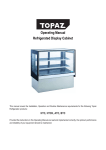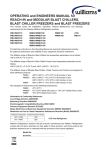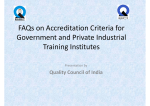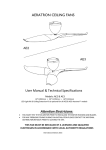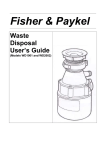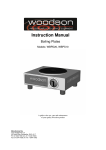Download User Manual - Comkit Online
Transcript
Williams Refrigeration Australia Operator and User Manual For standard upright and counter commercial refrigeration units Effective refrigeration is critical to achieving a productive and healthy foodservice operation. Proper ventilation and routine cleaning are critical to the effective performance and reliability of your refrigeration. Williams Refrigeration Australia Operator and User Manual Standard upright and counter commercial refrigeration units This manual covers the operation, cleaning and routine maintenance requirements for your Williams Refrigeration Australia foodservice refrigeration product. Provided the instructions in this Operator’s and Users Manual are read, understood and implemented correctly, the optimum performance and reliability of your equipment should be maintained. Energy efficiency Performing regular preventative maintenance and cleaning as detailed in this Operator and Users Manual is critical to ensuring the long term efficient operation of this product. Disposal of Old Cabinets Please ensure that old/redundant refrigeration cabinets and refrigeration equipment are disposed of safely and legally. Refrigeration equipment contains gases that could be harmful to the environment. Please ensure that proper degassing procedures are followed as part of the disposal process. Doors must be removed prior to disposal. © Williams Refrigeration Australia 2012 A troubleshooting section is included in this manual to assist with identifying potential problems. Like all commercial refrigeration units, this Williams product does require regular cleaning, maintenance and care as detailed in this Operator’s Manual. Please pay particular attention to the instructions on the location of this equipment, and especially in regard to ventilation requirements. Table of Contents Page 1. Introduction 4 2.Cabinet Location 4 3. Installation 5 4. M ains Connection 5 5. Operation 6 6. Cleaning 7 7.Routine Maintenance 8 8. Warranty 9 9. Troubleshooting 10 Williams Refrigeration Australia Operator and User Manual Page 4 1. Introduction 2. Cabinet Location Ventilation Details Commercial foodservice refrigeration such as this unit manufactured by Williams Refrigeration (Williams) is designed specifically to store product already chilled or frozen, at the required temperature. All commercial refrigeration equipment generates considerable heat as a part of normal operation. Uprights + Should product be loaded into any of these refrigeration cabinets that is not already chilled or frozen, the performance of your equipment could very well be compromised and other stored product adversely affected. CAUTION A minimum space of 300 mm from top and 100 mm from rear and sides of an upright cabinet must be maintained at all times to ensure efficiency of all Williams refrigerators. It is vital for correct equipment performance and reliability that adequate ventilation is provided to allow heat to dissipate Williams cabinets are designed for the commercial foodservice storage of chilled or frozen food and drinks. The use of Williams cabinets for any specialist food types, specialist products or other applications is not warranted unless subject to prior approval by Williams. The electronic controller of your Williams refrigeration cabinet is factory set at a predetermined temperature level and defrost frequencies as determined by the type and application of cabinet. Typical preset temperatures are: H CF M F L General Purpose 1°C to 4°C Chilled Food 0° to 3°C Meat –2° to +2°C Fish –2° to +2°C Frozen Food –18° to –22°C Transportation Transport the cabinet standing upright at all times. Do not lay the cabinet on sides or back; it must be kept upright at all times. Should access challenges be experienced when manoeuvring the equipment into position, such as moving through doorways etc., then it is permissible to tilt the cabinet by no more than 30° from the vertical. If tilting of the cabinet during transport or positioning has been necessary, then the cabinet must be allowed to stand for at least two hours before being powered on and operated. Note: Proper handling equipment must be used to move and position cabinets due to the awkward size and weight of most units. Refrigeration equipment generates heat Ventilation Requirements: Upright Cabinets As a guide, when operating a one door cabinet, up to 1,200 Watts of heat can be generated, a two door 1,800 Watts and a three door 2,400 Watts of heat. An exhaust fan may be fitted above a self contained unit if there is inadequate ventilation. This will help to remove some of the heat from the area. Any refrigeration equipment that is operated in a small, unventilated area, especially in warm weather, can cause the compressor to overheat and possibly result in it being permanently damaged. The least it will do is cause the refrigerator to use an excessive amount of electricity and possibly allow the contents to become spoiled. NOTE: FAILURE TO OBSERVE VENTILATION GUIDELINES WILL VOID THE MANUFACTURER’S WARRANTY! + Cabinets should not be located where direct sunlight, warm drafts, water, dust or grease is prevalent. Your cabinet is designed to operate at 65% RH. Humidity levels above 65% RH may cause excessive condensation. Do not store articles on top of uprights + Under no circumstances should an upright cabinet have anything stored on top of it, such as cardboard cartons or shelves built over the top, which will cut down on air circulation to the refrigeration unit. Page 5 Counters Special consideration must be given to the selection and installation of under counter models to ensure that proper ventilation is provided. Please consult with your Williams dealer or supplier if you are uncertain. A minimum space of 100 mm from the rear and sides of an under-counter cabinet must be maintained at all times to ensure operating efficiency. There must also be ample provision for the hot air exiting into the rear cavity to escape under or around the sides of the cabinet. 3. Installation General Notes LEVEL The cabinet should be standing level to ensure the correct operation of self closing doors and proper drainage of the condensate from the evaporator. CASTORS Special Installation notes Installation of marine application models with flanged feet for deck fixing and bulkhead fixings should be carried out by specialist marine companies. GASTRONORM FITTINGS Gastronorm model refrigerators or freezers are fitted with ladder racking and slides to take either gastronorm pans or shelves. All self-contained cabinets are fitted with castors for ease of movement to allow for cleaning under and rear of the cabinet. + Where lockable castors are fitted, they must be locked to prevent accidental cabinet movement during operation and use. This can be achieved by pressing the locking tab down with the foot. Ensure that both castors are locked. Remember to release the castor locks before attempting to move the cabinet. LEGS/PLINTHS Ventilation requirements: Under-counters + All counter cabinets must have a minimum of 100 mm at rear and be ventilated to ensure maximum air flow through the condensing unit. All counter cabinets must have the area in front of the condensing unit clear to ensure unobstructed air flow through the condensing unit. PLINTH mounted Please discuss the design of your mounting method with your Williams dealer or contact Williams directly prior to installation. Service Access Cabinets should not be installed in any manner that would impede normal service access. It is a general requirement in Australia that all built-in commercial refrigerated cabinets must be on a plinth, or legs that are a minimum of 150 mm high. Please check with your local building and Health inspectorate requirements. Adjustable legs may be supplied as an option when ordered. While it is intended that such cabinets are fitted with legs, they may be transported with small castors for ease of transport mobility. NOTE: Using interchangeable legs will typically increase the height of the cabinet by 30 mm. DRAINAGE All cabinets installed as remote systems require connections to drains or provision of a tundish. Check with local building and Health inspectorate requirements. Some self contained cabinets, such as fish cabinets also require drainage services to be provided. Please contact your dealer or Williams Refrigeration Australia for further information. Fitting for shelf or pan Shelf Loading Do not overload shelves. Remove some product if the shelves are bending. 4. Mains Connection This cabinet is suitable for connection to a nominal 240 volt, 50 Hz power supply. A dedicated power outlet should be used for the cabinet. Do not use power boards, extension leads, double adaptors or the like. A 3 pin moulded plug is fitted as standard to the mains lead. If the unit requires a 15 Amp circuit a 15 Amp plug will be fitted. + Never change a 15 Amp plug for a 10 Amp type. Page 6 Williams Refrigeration Australia Operator and User Manual 5. Operation Controller Display General Typical Controller Displays The cabinet is factory set according to the specifications for refrigerator and freezer. There is no need to adjust the controller as this may alter the design performance. Under normal operating conditions, the Freezer or Refrigeration controller displays the internal temperature of the cabinet at the sensor point. Loading Fridge [typical] 04 Freezer [typical] –1 8 Before loading any product, allow the cabinet to reach normal operating temperature. Corrosive foodstuffs such as vinegar, brine, seafood, cut tomatoes, cut onions, etc must be put into sealed containers to minimise the risk of cabinet rust and corrosion. All forced draught commercial + refrigeration units require constant air flow throughout the cabinet to maintain desired temperature. Correct loading of the cabinet must be considered for effective and efficient refrigeration performance. Never block the internal air vents that circulate the air around the cabinet and observe the load line within the cabinet. Allowing space for the air to circulate around the inside of the cabinet will help keep your product at the correct temperature. CAUTION: 4 Deg C -18 Deg C Temperature Set points are just that. They are not ‘accelerators’. Lowering set points will not increase the rate of cooling or performance of the system. If your cabinet is not holding temperature ensure that it has adequate ventilation, it is not overloaded, and that all routine maintenance and cleaning has been carried out. Indicators The controller includes indicators to show the status of the compressor and evaporator fans. These devices will cycle on and off during normal operation of the Freezer or Refrigeration unit. Freezer [typical] Compressor RUNNING Evaporator Fan RUNNING –1 8 -18 Deg C Restoring Temperature set points The following procedure can be followed to reset controller parameters should they be inadvertently altered. The Temperature Set Point as set and displayed is the lower target temperature. The Refrigeration system will work to hold the cabinet temperature within a four degree temperature band using the Temperature Set Point as the lower limit. To change Temperature Set Point, press and hold (for 4 seconds) controller buttons as per the following sequence: Defrost D F Defrost Cycle NOTE: The cabinet temperature may briefly rise above the set point following a defrost cycle. Increase Temperature Set Point: and Decrease Temperature Set Point: and Errors Correctly load cabinet Automatic Defrost Temperature probe errors: E1 E2 All forced draught cabinets in the Williams range are automatic defrost and this function is monitored by the electronic controller fitted to all cabinets. IMPORTANT: Call refrigeration service mechanic should such errors be indicated. All self contained cabinets have a heated tray fitted using hot gas waste from the compressor (except in the case of some specialised cabinets where an electric element is used). All Williams Refrigeration cabinets are factory set for the optimum storage temperature range as per the class of product. Refer table in section 1, Introduction. These vaporiser trays will thaw and evaporate all ice and moisture from the evaporator. This vaporising action results in steam emission and/or sounds of boiling water and may be heard. This is a normal consequence of the auto-defrost function. Check the source of any concerns prior to calling supply agent. Temperature Set Points WARNING: Accessing the controller to reprogram other critical equipment parameters may seriously affect the operation and performance of the equipment. Refer to your Refrigeration mechanic or your Williams Refrigeration agent if you have any doubts. Altering parameters outside of Williams factory set conditions could void warranty. Switching off Cabinets are not designed to be ordinarily switched off. Bacteria growth, mould, odours, rust or water overflow could occur. Note: Further Engineering details on all controller parameter set points can be obtained from Williams Refrigeration Australia. Page 7 6. Cleaning Cleaning Cabinet Surfaces Exterior The cabinet is finished in stainless steel or Colorbond steel and if cared for correctly, will keep the ‘as new’ look for many years. Normal day to day cleaning should be carried out with a soft cloth and soapy water. Stainless steel cabinets should always be cleaned by wiping the cabinet in the same direction as the grained polish as the finish can be spoiled by wiping against (or across) the grain. Never use abrasive cleaners, scouring pads or such materials on cabinets as these products can permanently damage the surface and, over time, may cause corrosion. Refer to the Stainless Steel Care brochure on our web site www.williamsref.com.au for more information. Regularly check gasket for damage that can be caused by being struck with sharp objects such as the edge of a tray or a knife. Damaged gaskets that do not seal correctly can increase the amount of power that is consumed and cause the evaporator to ice up. Either condition can cause the temperature within the cabinet to increase. Do not use any cleaning agents of a caustic based nature on door gaskets. Always ensure the gasket (including the gasket folds behind the inner edge), is kept clean and moisture free. Cleaning Cabinet Condenser 1 Turn the power off at the power point and unplug the power supply lead. If the power point is not readily accessible, turn off the isolation switch or the circuit breaker in the switchboard. 2 Carefully remove the unit cover above the doors if the cabinet is an upright or remove the cassette system if the cabinet is an under counter. Refer specific examples below. 3 Using a nylon brush carefully remove dust and dirt build up from the condenser (ensuring dust is not pushed back into condenser fins) and any dust that may have fallen into the area behind the control panel. NOTE: The condenser is located in the compressor compartment for self contained models. It looks like an assembly of aluminium fins with a fan arranged to blow ambient air through it. Manufacturer’s warranty does not cover failure of compressors due to blocked condensers. Do not use any cleaning agents of a caustic based nature, as these will have a detrimental effect on the cabinet surfaces. Interior Interior cleaning should be done on a regular basis with warm water and a soft cloth. Dry thoroughly afterwards. Remove shelves and pans for easy cleaning if required. Some models also provide for the removal of shelf support stripping (see section 3. Installation) to help facilitate thorough cleaning. CAUTION: All cabinets are fitted with electrical components and in particular, electronic controllers. These items must not be subjected to any levels of moisture entry. Evidence of such will automatically void any warranty. Cleaning Door Gaskets Clean weekly with warm mild soapy water (do not use harsh detergents) and a soft cloth. + DO NOT use a sharp knife to scrape or clean the gasket! The Condenser is mounted at the top of the cabinet for standard uprights or underneath for ‘under-mount’ uprights. Under-counter cabinets have the condenser in the motor compartment to the side of the cabinet. + Failure to keep the condenser clean will lead to higher temperatures in the cabinet, higher running costs and in most cases failure of the compressor or other components. A clean condenser is a critical factor in keeping your product operating correctly. Condenser Cleaning Procedure STOP Ensure that all Electrical Power to the unit is turned off before attempting to clean the Condenser! Cleaning Condenser Fins + To avoid personal injury by cuts, take care not to directly contact the fins as they are quite thin and may be sharp. + The fin material is extremely fragile and if bent can detrimentally alter the performance of the condenser unit. 4 The use of a vacuum cleaner will help in cleaning up the dislodged material. You should be able to see through the coil. 5 If the coil is badly blocked or you are uncertain, you should arrange (at your cost) for a qualified technician to do a comprehensive clean. 6 After removing all dirt from the condenser, replace the unit cover or cassette. 7 Reconnect the electrical supply and restart the cabinet. Williams Refrigeration Australia Operator and User Manual Page 8 Well covers CAUTION: Do not use water or cleaning fluids in the condenser area, as they may damage the refrigerator and possibly result in an electric shock when power is restored. Condenser access – Uprights Carefully remove the front unit area cover located above the door. The front cover can be removed on most models by pulling gently out on the top of the panel and raising slightly to unhook the bottom. Note: Models such as Diamond and Pearl Stars simply require that the cover be slid up vertically to remove. Condenser Access – Counters Removing Cassette 1 STOP Ensure that all Electrical Power to the unit is turned off before attempting to clean the Condenser! Replacing Cassette 2 Push cassette all the way back in. It may require a slight lift at the front to enable it to return to the final position. 3 Plug the cabinet back into the mains GPO and turn ON. 4 Ensure drain tube is in correct position. Blown Air Well Systems Many food preparation counters incorporate blown air well systems. Some food can find its way into the associated duct system. These ducts MUST be removed and cleaned regularly, at least every day to minimise Food Safety risk. Removing ducts for cleaning Blown air well counters are designed for use with the provided sliding covers. The covers should be slid across to access the required food product and then closed again. During peak periods the covers may be removed for a short time only (reduced working conditions). If not replaced the refrigeration system will be compromised and may ‘ice up’ affecting system performance and reliability. There should be no gaps between the pans. 7. Routine Maintenance The refrigerator or freezer is completely automatic in operation; that is, there is no need to manually defrost. A maintenance program however, is required to ensure a long life and trouble free use. A suggested maintenance program is as follows: Daily 2 Lift cassette up slightly at front and draw out of cabinet. 3 Stop half way and disconnect the internal power connector to the cassette Remove all pans from well 4 Continue to withdraw fully once power connector is disconnected. Reach into the well to the lower ‘joint’ in the duct and lift up Replacing Cassette + • Write these daily temperature readings in a small notebook. In this way, an average minimum and maximum operating temperature will be easily (and accurately) calculated for insertion into the Cabinet Service Log (see next). • Wipe all external surfaces with a soft cloth and warm soapy water. Rinse and wipe dry. Clean blown air well duct systems. Removing Cassette 1Lift cassette back into cabinet and slide back to mid point position. Reconnect cassette power lead inside the cabinet. Refer diagram “Replacing Cassette”. • Take note of the cabinet operating temperature. It is suggested that this be done at approximately the same time of day, to reduce temperature fluctuations caused by heavy use and/or the loading of a large quantity of product. Remove the complete duct for cleaning. Both sides of well. Remove any food debris and thoroughly clean all surfaces. Do not push any food scraps into the cabinet or fan system. NOTE: Before any extensive cleaning, always switch off the electrical supply and remove the plug from the electrical outlet. • Correct loading must be considered, to ensure correct air flows within cabinet. Page 9 • At all times, large items such as cardboard boxes should be placed at the bottom of the cabinet (in the top mounted upright cabinet) or at the far end of the cabinet opposite the evaporator (as in the under counter cabinet) to avoid restricting the cold air from the evaporator. Take note of the load line (See ‘Loading’ in the General Operation Section). Weekly • In addition to the daily maintenance items, cleaning of the door gasket each week is critical to the cabinet working efficiently. See ‘Cleaning Door Gasket/s’ in Section 6, Cleaning. Monthly • Follow the daily and weekly tasks as listed. • From the daily noted operating temperatures, determine the average maximum and minimum temperatures and record in the Cabinet Service Log (see next). It is suggested that this task is completed at the beginning of each month. • Every three months, the condenser must be cleaned of dust and other debris that will have collected. See the instructions under ‘Cleaning Condenser’, in Section 6, Cleaning. + IMPORTANT: In some applications, the condenser may need to be checked more frequently. For example in a dusty or greasy environment or where flour is prevalent, condenser cleaning should be carried out every fortnight. By monitoring the amount of condenser clogging that occurs, the frequency can be adjusted to suit individual situations Cabinet Service Log IMPORTANT: Warranty may be void if there is no evidence that a preventative maintenance program has been carried out on the equipment. It is best practise to create and maintain a cabinet service log to ensure that this work is carried out regularly and at recommended frequencies. Be sure to complete, sign and date the log when any preventative maintenance or service is carried out on the cabinet. • All condenser cleaning must be entered into the cabinet service log when the service takes place. Failure to do so will void warranty obligations by Williams Refrigeration and/or their suppliers/service providers, as tangible evidence will be required to support most warranty claims. 8. Warranty + Have the following information available when you call the warranty • The name of the business, the address, a contact name and phone number. How to make a warranty call department: • The name of the dealer from whom you purchased the equipment. Prior to making a warranty call please check the items in “Troubleshooting”. If after checking those items, the problem remains, please call the warranty department on 1800 338 148 or email [email protected] See page 11 for Warranty. • Cabinet model and serial number – this can be found on the label on the inside wall. R134a 580 Grams Serial Number Model • A brief description of the problem. Note: All warranty claims must be logged with and authorised by Williams prior to any work being carried out. Note: Williams approved warranty work undertaken by authorised service agents is arranged during normal working hours only (generally Monday – Friday, 8am to 4.30pm, excluding public holidays). Williams Refrigeration Australia Operator and User Manual Page 10 9. Troubleshooting A BLOCKED CONDENSER IS THE MOST COMMON CAUSE OF COMPRESSOR BREAKDOWN AND EQUIPMENT FAILURE! [See 7. Routine Maintenance] PROBLEM Cabinet not working POSSIBLE CAUSE ACTION Is there power to the cabinet? • Check mains lead is plugged in. • Check there is power to the GPO. Is there power to the condensing unit if under counter cabinet? • Check cassette power plug. See page 8. Condenser blocked with dirt. • Clean thoroughly - see “cleaning section”. Gasket not sealing. • Check condition of gasket - change if necessary. Call service engineer. • Check floor is level and door is closing correctly. Cabinet temperature too high Warm/fresh product has entered cabinet. • Refrigerator: Wait 30 mins for air to stabilise. • Freezer: Only use to store product that is already frozen. Cabinet defrost is on or just recently finished. • Wait for defrost to end. May be up to 20 mins. Refrigeration fault. • Call Williams (or service engineer for non-warranty). Poor ventilation around cabinet. • Refer to ventilation section pages 4 & 5. • Check for warm/ambient product in cabinet. • Check for over loading. Evaporator has iced up, stopping cold air flow through cabinet. • Check for gaskets not sealing. • Check door is closing correctly. • Check for set point too low. Cabinet temperature too low Set point inadvertently changed. • Program controller to correct values. Refrigeration fault. • Call Williams (or service engineer for non-warranty). Set point inadvertently changed. • Program controller to correct values. ‘E1’ displayed on controller Faulty air (cabinet) sensor probe. • Call Williams (or service engineer for non-warranty). ‘E2’ displayed on controller Faulty evaporator sensor probe. • Call Williams (or service engineer for non-warranty). No display at all in temperature indicator Interruption to power supply. • Check mains lead is plugged in. • Check power is switched on. • Check mains fuse. Cabinet not levelled correctly. • Adjust legs as per installation notes. Gasket damaged or torn. • Call service engineer to replace gasket. Cabinet door does not close properly • Pans to be in place at all times. Lids left off pans or pans not in place • Perspex lids to be in place at all times (refer Section 6). Sandwich, pizza or prep. well too warm or cabinet with these types of wells too warm Ambient air entering the cabinet over a short • Ensure Perspex lids are in place as much as possible. period or overnight. PLEASE NOTE: This condition is rarely a manufacturing fault • To remove ice, put product in another storage area (e.g. refrigerator). • Turn cabinet OFF with doors and well open. • Leave overnight. • Only turn unit back ON if all ice is completely defrosted. Doors not shut properly • Ensure door hinges are working properly. Gaskets not sealing properly • Check if gaskets are torn or damaged. Cassette not properly installed • Adjust cassette in place. Iced up evaporator Page 11 Equipment Warranty + Please refer to Williams Refrigeration Australia Terms and Conditions of Sale for full details. 16.Liability / Warranty 16.1 Except as the Terms specifically state, or as contained in any express warranty provided in relation to the goods or services, the Agreement does not include by implication any other term, condition or warranty in respect of the quality, merchantability, acceptability, fitness for purpose, condition, description, assembly, manufacture, design or performance of the goods or services or any contractual remedy for their failure. warranty period set out below (“Warranty”). 16.10Subject to the remainder of clause 16, Williams, in its reasonable discretion if it deems necessary, will repair or replace any goods to remedy any fault covered by Warranty, provided that: (b) 16.5 16.6 16.7 16.8 the goods or services are not of a kind ordinarily acquired for personal, domestic or household use or consumption, then the amount specified in section 276A(1) of the ACL is the absolute limit of Williams’ liability to the Customer; the goods or services are of a kind ordinarily acquired for personal, domestic or household use or consumption, payment of any amount required under section 274 of the ACL is the absolute limit of Williams’ liability to the Customer; howsoever arising under or in connection with the sale, installation, use of, storage or any other dealings with the goods or services by the Customer or any third party. any third party equipment that the Customer might have specified; the goods may have acceptable variance; and (j) (b) any replacement or repaired goods will only be warranted for the unexpired portion of the Warranty period attached to the original goods. any installation or removal costs necessary to access or service the goods; (k) any time spent on security clearance, inductions and suchlike; 16.11Unless stated otherwise, our standard warranty period and product covered is; (l) damage to, or breakage of, glass doors, gaskets, power leads, hinges, lights or plastic components; and (a) Williams brand self contained cabinets, 24 months from our original invoice date; (m) the failure of gaskets, lights, hinges, locks, TX valves and batteries. (b) Williams brand cabinets connected to a remote condenser, 12 months parts only warranty from our original invoice date; 16.14Williams reserves the right to replace defective parts of the goods with parts and components of similar quality, grade and composition where an identical part or component is not available. (c) Williams’ or its representative, at its option, having access to the goods for the purposes of inspection and verification of any claim; (d) the Customer accepting an invoice for any replacement parts claimed under Warranty, which will be reimbursed, excluding freight costs, only after confirmation of the claim by Williams; (e) The full payment of any invoices rendered by Williams to the Customer for non Warranty work; 16.4 If the Customer on-supplies the goods to a consumer and: (a) (i) (a) (c) Topaz brand cabinets, 12 months from our original 16.2 Williams products are not designed for nor have the invoice date; appropriate certifications, licences or accreditations for (d) Spare parts, 3 months from our original invoice date. use in personal, domestic or household applications. The Customer warrants that Williams products will not 16.12Provision of the Warranty is subject to: be used for such applications. To the extent permitted (a) the Customer not being in breach of these Terms or by law, Williams specifically does not warrant its any additional Agreement as may be in place; products used in such applications. (b) proof of purchase of the goods being directly from 16.3 If the Customer is a consumer nothing in these Terms Williams or an authorised distributor or agent of restricts, limits or modifies the Customer’s rights or Williams; remedies against Williams for failure of a statutory guarantee under the ACL. blockages or leaks in the refrigeration system, replacement refrigerant and components including TX valves, and wiring issues with controllers; 16.16The Customer warrants to use the goods in accordance with: (a) any instructions provided to it by Williams from time to time; (b) all government and local regulations, including but not limited to all relevant environmental laws and regulations governing the storage, installation, use, handling, maintenance and disposal of the goods. (c) all necessary and appropriate precautions and safety measures relating to the storage, installation, use, handling and maintenance of the goods. (d) Williams’ approved Warranty work undertaken by authorised service agents is arranged during our normal working hours only (generally Monday – Friday, 8am to 4.30pm, excluding public holidays). the Customer has not repaired or undertaken to repair the goods without prior authorisation from Williams 16.17The Customer bears the cost of making the Warranty nor altered the goods in any way; claim. (g) the Customer uses and maintains the goods in 16.18Approved Warranty repair work will be conducted for accordance with Williams’ instructions and in free only on the Australian mainland and within 50kms accordance with commonly accepted operating of a Williams Authorised service agent premises. If the practices; Customer is located more than 50km away, then any distance will be charged to the Customer on the excess (h) the Customer providing written notice within 3 days If clause 16.2 or 16.4 do not apply, then other at commercial rates. of delivery of any goods that it believes do not meet than as stated in the Terms or any written warranty specifications or goods that are defective; and 16.19Williams makes no express warranties or statement Williams is not liable to the Customer in representations other than as set out in this clause 16. (i) correct storage, siting and installation of the goods in any way arising under or in connection with the sale, accordance with Williams’ instructions. installation, use of, storage or any other dealings with 16.20The repair or replacement of the goods or part of the the goods or services by the Customer or any third goods is the absolute limit of Williams’ liability under 16.13The following Warranty exclusions apply: party. the Warranty. (a) Any product which Williams publishes as excluded Williams is not liable for any indirect or consequential 16.21The benefits of this Warranty are in addition to any from application of this Warranty; losses or expenses suffered by the Customer or any rights and remedies imposed by Australian State and (b) Any product for which the Warranty period published third party, howsoever caused, including but not Federal legislation that cannot be excluded. by Williams (in advertising material or otherwise) limited to loss of perishables, loss of turnover, profits, 16.22In the case of goods not manufactured by Williams differs from the Warranty period outlined above; business or goodwill or any liability to any other party but are sourced from third parties and supplied by except to the extent of any liability imposed by the (c) defects or malfunctions that are the result of incorrect Williams, this Warranty will not operate to extend the ACL. or poor maintenance by the Customer; terms of the original manufacturer of those goods. Nothing in the Terms is to be interpreted as excluding, (d) damage or alteration to the goods arising from 16.23Our contact details are: restricting or modifying or having the effect of circumstances outside the direct control of Williams, excluding, restricting or modifying the application of including, without limitation, power surges, disruptions, Williams Refrigeration Pty Ltd any State or Federal legislation applicable to the sale of flooding, fire or acts of god or where the goods are not 38-42 Gaine Road goods or supply of services which cannot be excluded, used for their intended purpose; Dandenong South, Victoria, 3175 restricted or modified. (e) any part of a refrigeration cabinet which has been Ph: 03-8787 4747 Where the Customer is a consumer, the following subject to misuse, neglect, alteration or changed in any Fax: 03-8787 4787 mandatory statement applies: Our goods come manner, incorrect installation or accident that has been Email: [email protected] with guarantees that cannot be excluded under caused by the Customer or its invitee; the Australian Consumer Law. You are entitled to a replacement or refund for a major failure and for compensation for any other reasonably foreseeable loss or damage. You are also entitled to have the goods repaired or replaced if the goods fail to be of acceptable quality and the failure does not amount to a major failure. 16.9 Williams warrants, subject to the exclusions and limitations below, the goods will be free from defects in materials and workmanship for the applicable (f) 16.15Goods presented for repair may be replaced by refurbished goods of the same type rather than being repaired. Refurbished parts may be used to repair the goods. (f) the failure of goods that have been supplied to a Customer’s specification or design and that failure was caused by a Customer specification or design fault; (g) any problem that might arise due to poor installation or siting of the goods, including but not limited to, lack of sufficient fresh air circulation, marine or mobile applications; (h) any problem that might arise out of the installation of remote cabinets, including but not limited to, Please refer to our website www.williamsref.com.au for current Terms and Conditions of Sale Williams Refrigeration Australia Operator and User Manual For standard upright and counter commercial refrigeration units Williams Refrigeration Australia Pty Ltd ABN 25 006 630 084 38-42 Gaine Road Dandenong South Victoria 3175 Australia Phone: 03 8787 4747 Fax: 03 8787 4787 Freecall: 1800 338 148 Email: [email protected] Website: www.williamsref.com.au R.T.A. AU03467












